bullets
 When the airmen went off to war, their hope was that their plane would be able to stand up to the attacks that would be coming their way. In World War II, big war planes were very new. The men who spent the war in them, needed a plane that would take a hit and keep on flying. They would love to have a flying suit of armor, but it also had to be able to fly. A plane that was too heavy, obviously wouldn’t fly, and yet, they needed a plane that could get hit with shrapnel or bullets and still stay in the air. They knew that they couldn’t make sure that every plane that was hit would make it home, but they needed as many as possible to do just that.
When the airmen went off to war, their hope was that their plane would be able to stand up to the attacks that would be coming their way. In World War II, big war planes were very new. The men who spent the war in them, needed a plane that would take a hit and keep on flying. They would love to have a flying suit of armor, but it also had to be able to fly. A plane that was too heavy, obviously wouldn’t fly, and yet, they needed a plane that could get hit with shrapnel or bullets and still stay in the air. They knew that they couldn’t make sure that every plane that was hit would make it home, but they needed as many as possible to do just that.
There were a number of planes that were considered almost indestructible, or at least as indestructible as it is possible to be for an airplane in a war zone. Two of them…the Boeing B-17 Flying Fortress, a four-engined heavy bomber developed in the 1930s for the United States Army Air Corps (USAAC), and the Boeing B-29 Superfortress, a US 4-engine propeller bomber, manufactured from 1943 to 1946 and used throughout the Korean War, as well as World War II. The name “Fortress” was coined when B-17, with its heavy firepower and multiple machine gun emplacements, made its public debut in July 1935. A reporter for The Seattle Times, Richard Williams, exclaimed, “Why, it’s a flying fortress!” The Boeing Company saw the value of that name and immediately had it trademarked. The truth of the matter is, however, that the planes had the ability to take a hit and still bring their boys home most of the time, provided the damage wasn’t too heavy.
These heavy bombers are bomber aircraft capable of delivering the largest payload of bombs, as well as the longest range, which is takeoff to landing distance, of their era. For those reasons, the heavy bombers are 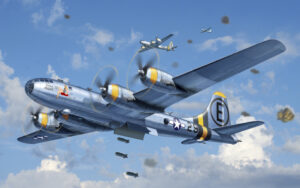 usually among the largest and most powerful military aircraft at any point in time. Nevertheless, as the 20th century wound down, the heavy bombers were largely superseded by strategic bombers. The strategic bombers were often smaller in size, which allowed for much longer ranges and by necessity, these were capable of delivering nuclear bombs. It was a sign of the times, but for all World War II buffs, like me, it was a sad end of an era. The newer planes are great, don’t get me wrong, but they just don’t have the presence, at least in my mind, that the World War II heavy bombers did. Those old planes had a grace that the newer stuff simply doesn’t have. I suppose that my love of the B-17, at least, stems from the fact that it was the plane that brought my dad home safely…so he could become my dad.
usually among the largest and most powerful military aircraft at any point in time. Nevertheless, as the 20th century wound down, the heavy bombers were largely superseded by strategic bombers. The strategic bombers were often smaller in size, which allowed for much longer ranges and by necessity, these were capable of delivering nuclear bombs. It was a sign of the times, but for all World War II buffs, like me, it was a sad end of an era. The newer planes are great, don’t get me wrong, but they just don’t have the presence, at least in my mind, that the World War II heavy bombers did. Those old planes had a grace that the newer stuff simply doesn’t have. I suppose that my love of the B-17, at least, stems from the fact that it was the plane that brought my dad home safely…so he could become my dad.
 Most of us have heard of shrapnel. Shrapnel shells have been obsolete since the end of World War I for anti-personnel use, but they were “anti-personnel artillery munitions which carried many individual bullets close to a target area and then ejected them to allow them to continue along the shell’s trajectory and strike targets individually. They relied almost entirely on the shell’s velocity for their lethality.” These days, high-explosive shells are used for that role. The functioning and principles behind Shrapnel shells are fundamentally different from high-explosive shell fragmentation. Shrapnel is named for its inventor, Lieutenant-General Henry Shrapnel (1761–1842). Shrapnel was a British artillery officer, whose experiments, initially conducted on his own time and at his own expense, culminated in the design and development of a new type of artillery shell.
Most of us have heard of shrapnel. Shrapnel shells have been obsolete since the end of World War I for anti-personnel use, but they were “anti-personnel artillery munitions which carried many individual bullets close to a target area and then ejected them to allow them to continue along the shell’s trajectory and strike targets individually. They relied almost entirely on the shell’s velocity for their lethality.” These days, high-explosive shells are used for that role. The functioning and principles behind Shrapnel shells are fundamentally different from high-explosive shell fragmentation. Shrapnel is named for its inventor, Lieutenant-General Henry Shrapnel (1761–1842). Shrapnel was a British artillery officer, whose experiments, initially conducted on his own time and at his own expense, culminated in the design and development of a new type of artillery shell.
Henry Shrapnel was born June 3, 1761 at Midway Manor in Bradford-on-Avon, Wiltshire, England, the ninth child of Zachariah Shrapnel and his wife, Lydia. Shrapnel became an artillery officer and inventor of a form of artillery case shot (shrapnel). He was commissioned in the  Royal Artillery in 1779, and served in Newfoundland, Gibraltar, and the West Indies. He was wounded in Flanders in the Duke of York’s unsuccessful campaign against the French in 1793. In 1804 he became an inspector of artillery and spent several years at Woolwich arsenal.
Royal Artillery in 1779, and served in Newfoundland, Gibraltar, and the West Indies. He was wounded in Flanders in the Duke of York’s unsuccessful campaign against the French in 1793. In 1804 he became an inspector of artillery and spent several years at Woolwich arsenal.
In 1784, while a lieutenant in the Royal Artillery, he perfected, with his own resources, an invention of what he called “spherical case” ammunition: a hollow cannonball filled with lead shot that burst in mid-air. He successfully demonstrated this in 1787 at Gibraltar. He intended the device as an anti-personnel weapon. In 1803, the British Army adopted a similar, but elongated explosive shell which immediately acquired the inventor’s name. It has lent the term “shrapnel” to fragmentation from artillery shells and fragmentation in general ever since, long after it was replaced by high explosive rounds, but this usage is not the original 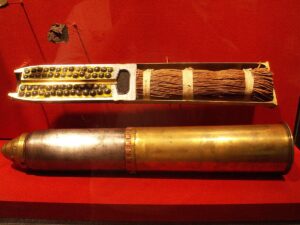 meaning of the word. Until the end of World War I, the shells were still manufactured according to his original principles.
meaning of the word. Until the end of World War I, the shells were still manufactured according to his original principles.
In 1814, the British Government recognized Shrapnel’s contribution by awarding him £1200 (UK£ 85,000 in 2021) a year for life, however, bureaucracy kept him from receiving the full benefit of this award. He was promoted to the office of Colonel-Commandant, Royal Artillery, on March 6, 1827, and to the rank of lieutenant-general on January 10, 1837. Shrapnel lived at Peartree House, near Peartree Green, Southampton from about 1835 until his death on March 13, 1842 at Southampton, Hampshire.
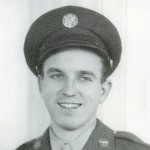
 As I have researched the infantry soldiers of World War II, my thought was that I was really thankful that my dad, Allen Spencer was not one of those men on the ground during the fighting. I felt bad for those men who were on the ground, fighting from the foxholes. I still do, because they were in constant danger. Bombs fall from the sky, and bullets fly from across the battlefield. If those things didn’t kill a soldier, the freezing cold, trench foot, or dysentery from the horribly unsanitary conditions could. It seemed that my dad’s situation was by far safer, but now, I’m not so sure that’s true.
As I have researched the infantry soldiers of World War II, my thought was that I was really thankful that my dad, Allen Spencer was not one of those men on the ground during the fighting. I felt bad for those men who were on the ground, fighting from the foxholes. I still do, because they were in constant danger. Bombs fall from the sky, and bullets fly from across the battlefield. If those things didn’t kill a soldier, the freezing cold, trench foot, or dysentery from the horribly unsanitary conditions could. It seemed that my dad’s situation was by far safer, but now, I’m not so sure that’s true.
The book I had been listening to, that took in World War II from D-Day to The Battle of the Bulge, talked mostly about the ground war, but then at the end, the reader said something that really struck me. It was about the look that crossed the face of a bomber crew’s faces before certain missions…those that would inevitably find the plane flying through flak. The look was one of fear. I knew flak was dangerous, but somehow I didn’t really connect flak with bringing down a plane, or seriously injuring its occupants. Nevertheless, it is quite dangerous for them.
As I researched the dangers of flak, a shocking revelation made itself known. I had written a story about the life expectancy of the ball turret gunner. My findings were that that life expectancy was about 12 seconds. That may be true when one is talking about the prospect of being shot, but when it comes to flak, that cannot be said. Apparently, where flak is concerned, the best place to be is in the plexiglass structure of the ball turret. Plexiglass holds up better against flak than other areas of the plane, so the ball turret gunner is much more protected…at least from flak. The same cannot be said for the bullets flying through the area. I was thankful that my dad was not a ball turret gunner, and that he only filled in as a waist gunner periodically. The waist gunners were in the open, where protection from bullets, and from flak was minimal…at best, non-existent at worst. I can’t imagine how those memories must have affected my dad, but in the book I listened to, the main reason many of the men didn’t want to talk about their experiences in World War II, or any war, was because talking about it brought those memories flooding in again.
After researching flak, and how it works, I can see why the men would get a look of fear on their faces as they prepared to go through areas anti-aircraft weapons shooting flak into the air. Some men said that they could see the red hot glow in the center of the flak, if it was very close. That tells me that it was like a small explosive devise. No wonder it could bring so much damage to a plane. I had known that flak could put holes in the fuselage, but somehow I hadn’t tied that with bringing down a plane. I surmise that it was the B-17 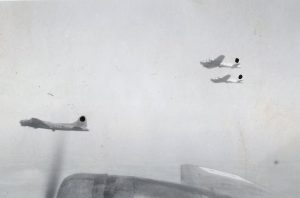
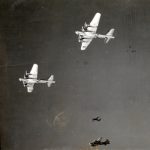 bomber top turret gunner’s daughter in me that wouldn’t allow me to place that danger around my dad. I didn’t want to think about the dangers of his every mission in World War II. My mind seems to have placed his plane in a bubble or a force field, so that no danger could come near him. I think every veteran wonders why they were spared, when others didn’t make it back home. I don’t think anyone can answer that question. As a Christian, I have to credit God for bringing my future dad home.
bomber top turret gunner’s daughter in me that wouldn’t allow me to place that danger around my dad. I didn’t want to think about the dangers of his every mission in World War II. My mind seems to have placed his plane in a bubble or a force field, so that no danger could come near him. I think every veteran wonders why they were spared, when others didn’t make it back home. I don’t think anyone can answer that question. As a Christian, I have to credit God for bringing my future dad home.
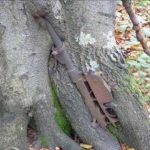
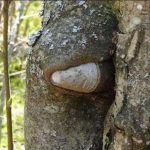
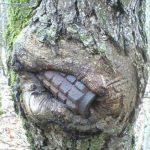 In any war, when soldiers are killed or wounded in battle, their guns, grenades, and bullets were left behind…forgotten. Those who assisted the wounded and carried off the dead, had more important things to attend to than the soldier’s weapons and such, which were simply left behind…discarded. As the front lines shifted from one area to another, battlefields were deserted, and in the absence of the trampling footsteps of the soldiers, the grass and low plants began to grow again. As the months and years passed, trees continued to grow. The littered items somehow became embedded in the bark of the growing trees. That phenomena has always amazed me. How could the tree bark accept this odd foreign object into itself…and yet it did. Of course, it was not without scars that the odd pair would coexist. The foreign items would be wrapped with a knotted looking bulge, or would appear to eat up portions of the foreign object, while completely ignoring another part, as if it was simply laying beside it.
In any war, when soldiers are killed or wounded in battle, their guns, grenades, and bullets were left behind…forgotten. Those who assisted the wounded and carried off the dead, had more important things to attend to than the soldier’s weapons and such, which were simply left behind…discarded. As the front lines shifted from one area to another, battlefields were deserted, and in the absence of the trampling footsteps of the soldiers, the grass and low plants began to grow again. As the months and years passed, trees continued to grow. The littered items somehow became embedded in the bark of the growing trees. That phenomena has always amazed me. How could the tree bark accept this odd foreign object into itself…and yet it did. Of course, it was not without scars that the odd pair would coexist. The foreign items would be wrapped with a knotted looking bulge, or would appear to eat up portions of the foreign object, while completely ignoring another part, as if it was simply laying beside it.
Like the weapons of war, the soldiers’ helmets were often discarded in an injury or more likely death situation. The likelihood of survival for the owner of a helmet that contained a bullet hole, was slim to none. The helmet was not likely to be needed by its owner again, so the helmet lay on the battlefield where it had been discarded. As time went on, the little sapling trees growing up after the end of the war started up under the helmet. In order for the tree to grow up, it had to make its way, somehow through the helmet or to topple it in order to survive. A bullet hole provided the perfect way to get through the heavy helmet. The tiny tree peeked through the hole to find the sunlight necessary for the tree’s survival. As the tree grew, the corroding helmet allowed the hole to be expanded, and the tree became larger. Soon the helmet became a part of the growing tree. There was not a knotted wrapping of the tree around the helmet, but rather the helmet took on a mushroom like appearance. It looked like an odd sort of umbrella to anyone who might come across this odd marriage of nature and the man-made helmet. Only on occasion did the tree protest the marriage, or the helmet refuse to allow the expansion of the hole, thereby creating the knot that was so often seen as the tree 

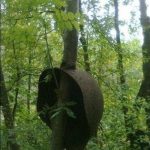 absorbed the foreign object. Even then, the tree could not fully absorb the helmet, and so it looked almost like the tree was wearing the helmet on its knotted head…and the branches protruding from the knot looked like messy hair. The strange looking trees, were a lingering reminder of a war that was long over, but somehow not forgotten…and nature prevails.
absorbed the foreign object. Even then, the tree could not fully absorb the helmet, and so it looked almost like the tree was wearing the helmet on its knotted head…and the branches protruding from the knot looked like messy hair. The strange looking trees, were a lingering reminder of a war that was long over, but somehow not forgotten…and nature prevails.
 The Gallipoli campaign took place between April 1915 and December 1915 in an effort to take the Dardanelles from the Turkish Ottoman Empire…an ally of Germany and Austria, and thus force it out of the war. About 60,000 Australians and 18,000 New Zealanders were part of a larger British force. Among the wounded were some 26,000 Australians and 7,571 New Zealanders, while 7,594 Australians and 2,431 New Zealanders were killed. Numerically, Gallipoli was a minor campaign, but it took on considerable national and personal importance to the Australians and New Zealanders who fought there.
The Gallipoli campaign took place between April 1915 and December 1915 in an effort to take the Dardanelles from the Turkish Ottoman Empire…an ally of Germany and Austria, and thus force it out of the war. About 60,000 Australians and 18,000 New Zealanders were part of a larger British force. Among the wounded were some 26,000 Australians and 7,571 New Zealanders, while 7,594 Australians and 2,431 New Zealanders were killed. Numerically, Gallipoli was a minor campaign, but it took on considerable national and personal importance to the Australians and New Zealanders who fought there.
The Gallipoli Campaign was Australia’s and New Zealand’s introduction to the Great War. Many Australians and New Zealanders fought on the Peninsula from the day of the landings (April 25, 1915) until the evacuation on December 20, 1915. The 25th April is the New Zealand equivalent of Armistice Day and is marked as the ANZAC day in both countries with Dawn Parades and  other services in every city and town. Shops are closed in the morning. It is a very important day to Australians and New Zealanders for a variety of reasons that have changed and transmuted over the years. This campaign, while small in losses, was huge in the hearts of the Australians and New Zealanders.
other services in every city and town. Shops are closed in the morning. It is a very important day to Australians and New Zealanders for a variety of reasons that have changed and transmuted over the years. This campaign, while small in losses, was huge in the hearts of the Australians and New Zealanders.
While many losses came out of this campaign, it seems that there were two who were saved…potentially anyway. After the campaign was over, and people were wandering the area, someone came across an unusual, and seriously rare, find. There on the ground were two bullets that had collided with each other in mid-air, thus saving the lives of the two combatants who fired the rounds. Obviously, they could have been hit by another round, in which case the mid-air collision only slightly prolonged their lives. At least this scenario might be what you would think. The reality is that you would be wrong. Taking a look closer at the bullets, it is quite obvious that one round collided with 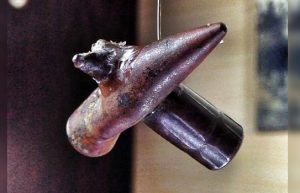 another. But the round on the left doesn’t have any rifling on it, whereas the round on the right does. They collided, but in reality, the round on the left probably wasn’t moving as fast as an actual speeding bullet. Maybe it was part of a clip on an ANZAC soldiers webgear as he was in an attack, or some other bizarre reason. But this most certainly wasn’t the intersection of two trajectories between the lines…making such a collision between two bullets even more rare. Nevertheless, the picture itself is quite interesting, and would have caught the eye of anyone looking at it. How they got there really makes no difference, but the fact that they were found on the Gallipoli battlefield makes them an interesting find. If you ask me, it is still a very rare occurrence.
another. But the round on the left doesn’t have any rifling on it, whereas the round on the right does. They collided, but in reality, the round on the left probably wasn’t moving as fast as an actual speeding bullet. Maybe it was part of a clip on an ANZAC soldiers webgear as he was in an attack, or some other bizarre reason. But this most certainly wasn’t the intersection of two trajectories between the lines…making such a collision between two bullets even more rare. Nevertheless, the picture itself is quite interesting, and would have caught the eye of anyone looking at it. How they got there really makes no difference, but the fact that they were found on the Gallipoli battlefield makes them an interesting find. If you ask me, it is still a very rare occurrence.
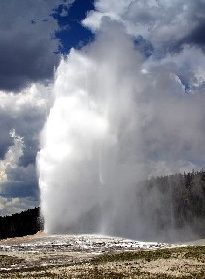 It’s amazing how much we can fear the things we don’t understand. As an example, the Indians who lived around the geysers of Yellowstone. The early Indians thought that the hissing and thundering were the voices of evil spirits. Even though the geysers were frightening, the Indians regarded the mountains at the head of the river as the crest of the world, and the man who gained their summits could see the happy hunting-grounds below, brightened with the homes of the blessed. They loved this land in which their fathers had hunted, and when they were driven back from the settlements the Crows took refuge in what is now Yellowstone Park, but they were still not safe.
It’s amazing how much we can fear the things we don’t understand. As an example, the Indians who lived around the geysers of Yellowstone. The early Indians thought that the hissing and thundering were the voices of evil spirits. Even though the geysers were frightening, the Indians regarded the mountains at the head of the river as the crest of the world, and the man who gained their summits could see the happy hunting-grounds below, brightened with the homes of the blessed. They loved this land in which their fathers had hunted, and when they were driven back from the settlements the Crows took refuge in what is now Yellowstone Park, but they were still not safe.
The soldiers pursued them, intent on avenging acts that the red men had committed while they were being so wrongly mistreated. A small group of the original fugitive band gathered at the head of that mighty rift in the earth known as the Grand Canyon of the Yellowstone…a group that had succeeded in escaping the bullets of the soldiers, and with great courage they resolved to die rather than be taken and carried away to be held in a distant prison. They built a raft and laced it on the river at the foot of the upper fall, and for a few days they 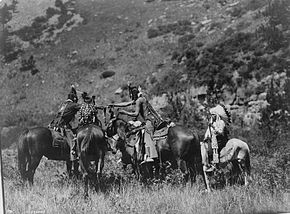 enjoyed the plenty and peace that were their privilege in former times. A short-lived peace, however, for one morning they are awakened by the rifle fire, and they knew that the troops are upon them.
enjoyed the plenty and peace that were their privilege in former times. A short-lived peace, however, for one morning they are awakened by the rifle fire, and they knew that the troops are upon them.
Boarding their raft they thrust it toward the middle of the stream, perhaps with the idea of making it to the opposite shore. If that was their intent, the rapid current kept them from attaining their goal. A few among them had guns, but their bullets had only a slight effect at the troops, who stood watching in amazement from the shore. The soldiers didn’t fire, but watched, with something like dread, the descent of the raft as it passes into the current. Then, with many a turn and pitch, it whirled on faster and faster. The death-song rises triumphant above the lash of the waves and that distant but awful booming that is to be heard in the 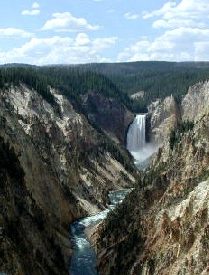 canyon. Every red man has his face turned toward the foe with a look of defiance, and the tones of the death-chant have in them something of mockery and hate. The Indians went defiantly to their deaths, refusing to show the slightest amount of fear.
canyon. Every red man has his face turned toward the foe with a look of defiance, and the tones of the death-chant have in them something of mockery and hate. The Indians went defiantly to their deaths, refusing to show the slightest amount of fear.
The raft was now between the jaws of the rocks. Beyond and below are vast walls, shelving toward the floor of the gulf a thousand feet below. The beauty of the falls will be their last vision…brilliant colors shining in the sun of morning that sheds as peaceful a light on wood and hill. They believe they are heading to a place where humans don’t shoot human, and where they will be free again. The raft was galloping through the foam like a racehorse, and even the hardened soldiers could not hold back the shudder as they imagined the fate of the brave Indians. Now the brink is reached. The raft tips toward the gulf, and with a cry of triumph the red men are launched over the cataract, into the bellowing chasm, and the rocky floor that waited below.

